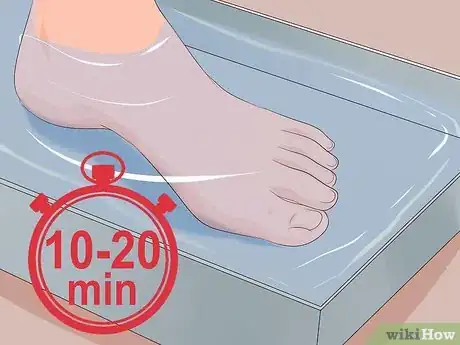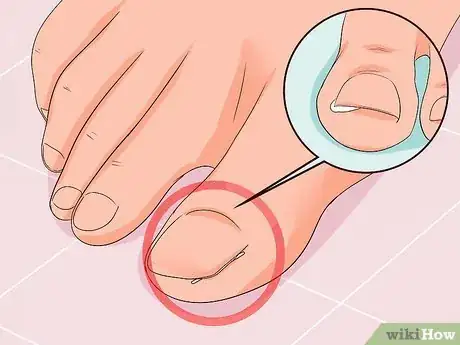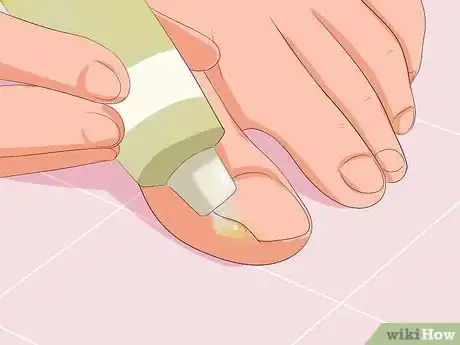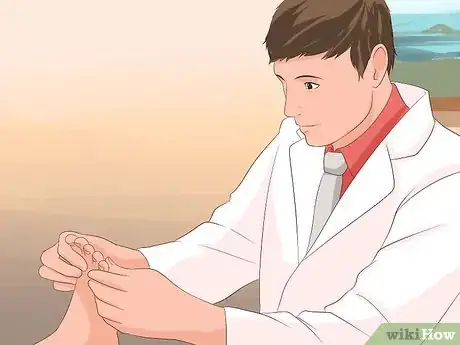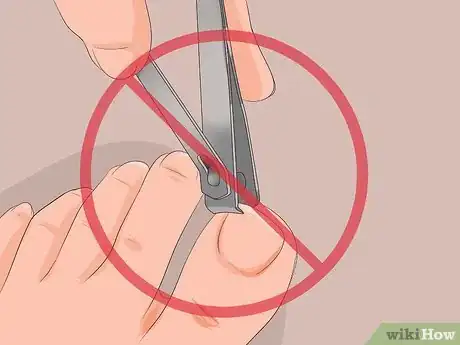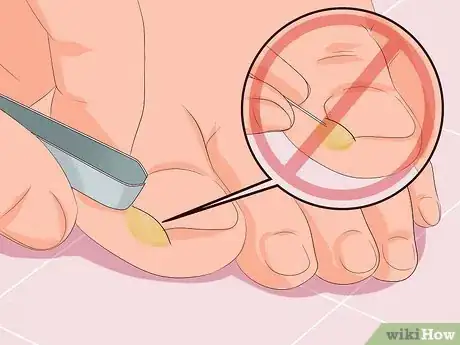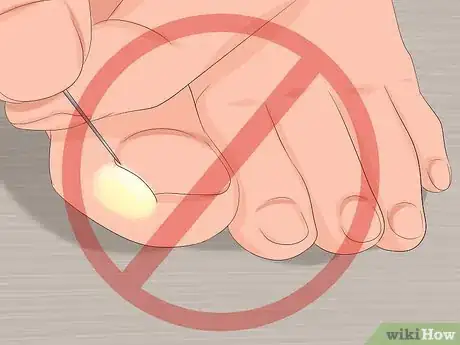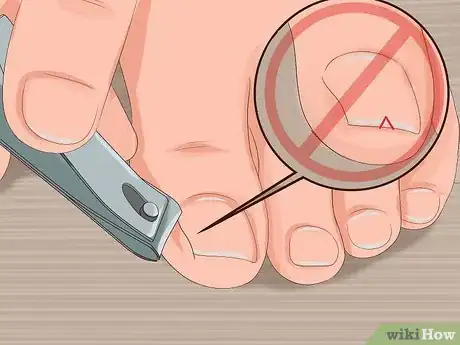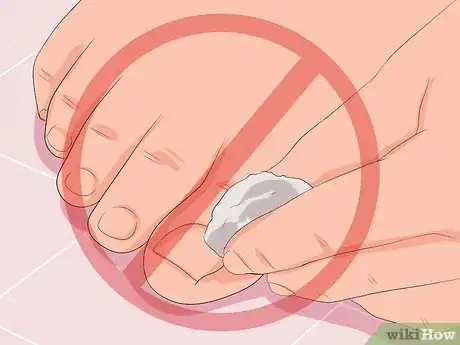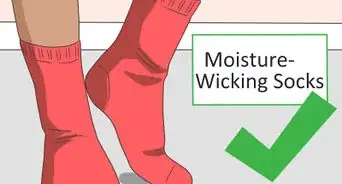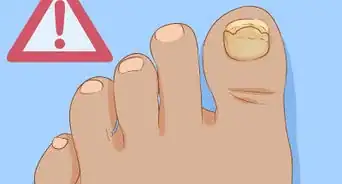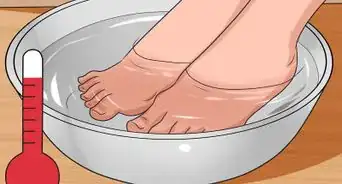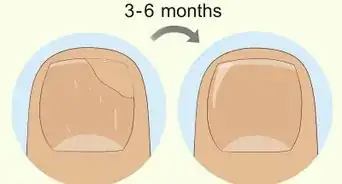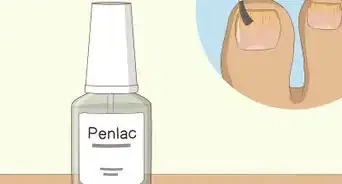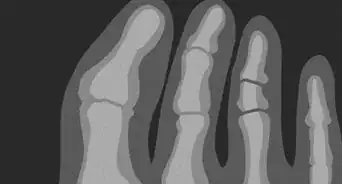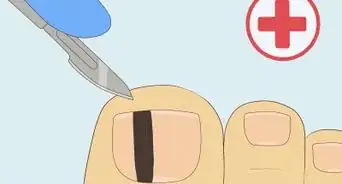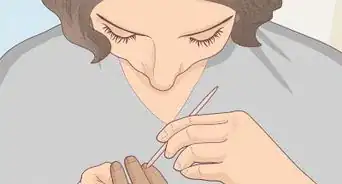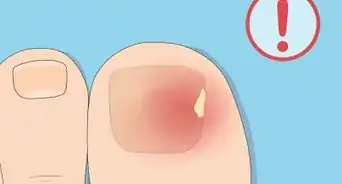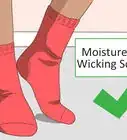This article was co-authored by Mark Co, DPM. Dr. Mark Co is a Podiatrist who runs his own private practice in San Francisco, California. Dr. Co specializes in treatments for bunions, ingrown toenails, toenail fungus, warts, plantar fasciitis and other causes of foot pain. He also offers custom orthotics for the treatment and prevention of foot and ankle issues. Dr. Co completed a Master of Business Administration (MBA) at New York University and an MA in Electrical Engineering and Computer Science at Johns Hopkins University. Dr. Co also completed his DPM at the California School of Podiatric Medicine and a residency and internship at the Kaiser Permanente Medical Center, Santa Clara, California. Dr. Co was awarded San Francisco's "Top 3 Podiatrists" in 2018, 2019, and 2020. Dr. Co is also a member of the CPMA (American Podiatric Medical Association).
wikiHow marks an article as reader-approved once it receives enough positive feedback. This article received 21 testimonials and 86% of readers who voted found it helpful, earning it our reader-approved status.
This article has been viewed 1,969,664 times.
Ingrown toenails can be painful and inconvenient, and worst of all, they can get infected easily. If you are suffering from an ingrown toenail that has become infected, you'll need to treat the infection to prevent the condition from worsening.[1] To remove infection from an ingrown toenail, soften the nail in warm water before carefully propping up the edge and applying antibacterial ointment directly to the infection beneath the nail. While this is a decent start, it is strongly advised to visit a podiatrist for proper treatment instead of relying on home treatment for the infection.
Steps
Treating the Nail
-
1Soak your toe. In order to reduce the pain and swelling involved with an ingrown toenail, soak the foot with the ingrown toenail for 10-20 minutes in warm, soapy water, three times a day for one to two weeks. The Epsom salt can also help with pain and inflammation.[2]
- Fill a tub with about 0.5 US gal (1.9 L) of warm water and add 3 tbsp (75 g) of Epsom salt. Place your foot into the water, and relax for about 15 minutes while it soaks.[3] When finished soaking, dry your toe completely.
- You can do this multiple times a day, or as needed while your toenail is growing out.[4] int
- Never soak your foot in hot water. It should always be soaked in warm water.[5]
-
2Prop up the edge of the nail. To relieve the pressure under the ingrown edge of the toenail, doctors sometimes suggest propping the nail up slightly. This is done by sticking a small piece of cotton or thick floss under the edge of the nail. This technique helps pull the nail away from the skin, so it no longer digs into the skin.
- If you use cotton, you can dip it in antiseptic to help ease the pain and prevent infection under the nail.
- If the nail is infected, this may also help to soak up any moisture that is trapped under the nail.
- If you use thick floss, make sure that it is unflavored and unwaxed.
- Do not insert a metal tool under the nail to try to insert cotton or floss. This could damage the toe further.[6]
Advertisement -
3Apply antibacterial ointment. Antibacterial ointment is helpful when dealing with an infected ingrown toenail. Before you apply the ointment, dry your toe completely. Cover the infected area with an antibacterial cream. Apply the ointments in a thick coat over the infected area of the toe. Wrap your toe with a bandage such as a large band-aid. This prevents debris from entering the wound and keeps the ointment in place.
- Use antibacterial ointments such as Neosporin.[7]
-
4Visit a foot doctor (podiatrist). Ingrown toenails that become infected should not be treated at home, which is true for most infected wounds. Visit a podiatrist, more commonly known as a foot doctor, to get treatment for your infection. If the infection and nail are bad enough, minor surgery may be required. For the most part, however, a simple surgical procedure involving numbing the nail bed and then removing part of the ingrown nail with clippers or scissors by the doctor,
- You may be prescribed oral antibiotics, which are taken by mouth, to help fend off further infections.[8] If you are prescribed antibiotics, make sure you complete the entire course and follow up with your doctor as needed.
Avoiding Common Misconceptions
-
1Do not cut the nail. A common misconception about having an infected ingrown toenail is that it needs to be cut. Contrary to popular belief, cutting the nail can make the infection worse. It can also cause more ingrown toenails in the future. Leave the nail uncut, and prop it up to relieve pressure.
- The toenail may need to be cut by a doctor, but should not be done at home in ‘bathroom surgery’.[9]
-
2Do not dig under the nail. It may be tempting to try to relieve pressure or lift the nail from the skin by digging at the skin underneath. Do not do this because it can intensify an infection and make the ingrown nail worse.
- Stay away from your toenails with tweezers, orange sticks, clippers, files, or any other metal tools.[10]
-
3Do not attempt to drain an infection. There is a popular conception that you should use a needle to puncture a blister or a pustule caused by an infection. You should not do this because it will just make it worse. Even if you use clean tools and a sanitized needle, you can cause some serious damage by poking and prodding at a blister or infected wound.
- Avoid touching it with anything other than a cotton swab or bandaging materials.[11]
-
4Do not cut a ‘V’ in the nail. According to some old folk healing methods, you should cut a ‘V’ shape in the top of the infected toenail to relieve the pressure, which in turn will heal the nail. However, doing this does absolutely nothing except create a jagged edge on your nail.
-
5Avoid coating your toe. Do not believe urban health myths such as rubbing coal on your toe to make an infection go away. Although some people swear by this method, the coal won’t benefit the infection or the ingrown nail at all. In fact, this method may make it worse. In general, you should not put anything on your toe or the infected area except for antibiotic cream or bandages.
Expert Q&A
-
QuestionI have two infections on either side of my right toe and it's gotten so bad there is two lumps of skin or infection completely covering the corners of either side of my toe. What should I do? Do I need surgery?
 Chris M. Matsko, MDDr. Chris M. Matsko is a retired physician based in Pittsburgh, Pennsylvania. With over 25 years of medical research experience, Dr. Matsko was awarded the Pittsburgh Cornell University Leadership Award for Excellence. He holds a BS in Nutritional Science from Cornell University and an MD from the Temple University School of Medicine in 2007. Dr. Matsko earned a Research Writing Certification from the American Medical Writers Association (AMWA) in 2016 and a Medical Writing & Editing Certification from the University of Chicago in 2017.
Chris M. Matsko, MDDr. Chris M. Matsko is a retired physician based in Pittsburgh, Pennsylvania. With over 25 years of medical research experience, Dr. Matsko was awarded the Pittsburgh Cornell University Leadership Award for Excellence. He holds a BS in Nutritional Science from Cornell University and an MD from the Temple University School of Medicine in 2007. Dr. Matsko earned a Research Writing Certification from the American Medical Writers Association (AMWA) in 2016 and a Medical Writing & Editing Certification from the University of Chicago in 2017.
Family Medicine Physician I recommend that you see a podiatrist. They can do an in-office surgical procedure.
I recommend that you see a podiatrist. They can do an in-office surgical procedure. -
QuestionShould you use peroxide on the toe?
 Chris M. Matsko, MDDr. Chris M. Matsko is a retired physician based in Pittsburgh, Pennsylvania. With over 25 years of medical research experience, Dr. Matsko was awarded the Pittsburgh Cornell University Leadership Award for Excellence. He holds a BS in Nutritional Science from Cornell University and an MD from the Temple University School of Medicine in 2007. Dr. Matsko earned a Research Writing Certification from the American Medical Writers Association (AMWA) in 2016 and a Medical Writing & Editing Certification from the University of Chicago in 2017.
Chris M. Matsko, MDDr. Chris M. Matsko is a retired physician based in Pittsburgh, Pennsylvania. With over 25 years of medical research experience, Dr. Matsko was awarded the Pittsburgh Cornell University Leadership Award for Excellence. He holds a BS in Nutritional Science from Cornell University and an MD from the Temple University School of Medicine in 2007. Dr. Matsko earned a Research Writing Certification from the American Medical Writers Association (AMWA) in 2016 and a Medical Writing & Editing Certification from the University of Chicago in 2017.
Family Medicine Physician Hydrogen peroxide is a good agent to control infection and help relieve some of the pus and pain involved with an ingrown toenail. I would put a band aid over the nail after I cleaned it out with peroxide.
Hydrogen peroxide is a good agent to control infection and help relieve some of the pus and pain involved with an ingrown toenail. I would put a band aid over the nail after I cleaned it out with peroxide. -
QuestionHow can I treat an ingrown toenail that's causing an infection?
 Mark Co, DPMDr. Mark Co is a Podiatrist who runs his own private practice in San Francisco, California. Dr. Co specializes in treatments for bunions, ingrown toenails, toenail fungus, warts, plantar fasciitis and other causes of foot pain. He also offers custom orthotics for the treatment and prevention of foot and ankle issues. Dr. Co completed a Master of Business Administration (MBA) at New York University and an MA in Electrical Engineering and Computer Science at Johns Hopkins University. Dr. Co also completed his DPM at the California School of Podiatric Medicine and a residency and internship at the Kaiser Permanente Medical Center, Santa Clara, California. Dr. Co was awarded San Francisco's "Top 3 Podiatrists" in 2018, 2019, and 2020. Dr. Co is also a member of the CPMA (American Podiatric Medical Association).
Mark Co, DPMDr. Mark Co is a Podiatrist who runs his own private practice in San Francisco, California. Dr. Co specializes in treatments for bunions, ingrown toenails, toenail fungus, warts, plantar fasciitis and other causes of foot pain. He also offers custom orthotics for the treatment and prevention of foot and ankle issues. Dr. Co completed a Master of Business Administration (MBA) at New York University and an MA in Electrical Engineering and Computer Science at Johns Hopkins University. Dr. Co also completed his DPM at the California School of Podiatric Medicine and a residency and internship at the Kaiser Permanente Medical Center, Santa Clara, California. Dr. Co was awarded San Francisco's "Top 3 Podiatrists" in 2018, 2019, and 2020. Dr. Co is also a member of the CPMA (American Podiatric Medical Association).
Podiatrist Soak your toenail in 2 quarts of warm water mixed with 3 tbsp Epsom salt. Do this for about 15 minutes any time your toe is hurting while the nail grows out.
Soak your toenail in 2 quarts of warm water mixed with 3 tbsp Epsom salt. Do this for about 15 minutes any time your toe is hurting while the nail grows out.
Warnings
- Individuals with immune problems should see a doctor for any lingering infections.⧼thumbs_response⧽
- Infections may become life-threatening if they manifest with sepsis or cause blood poisoning. You can also develop gangrenous infections, which creates dead, decaying tissues. These things may require hospitalization, surgeries, and even amputations to stop spreading or dying tissues.⧼thumbs_response⧽
- If you have an ingrown toenail and know you are diabetic, you should see a foot doctor as soon as possible.⧼thumbs_response⧽
- Problems with the healing of ulcers or numbness and tingling in the feet can indicate diabetes.⧼thumbs_response⧽
References
- ↑ http://www.webmd.com/skin-problems-and-treatments/tc/ingrown-toenail-topic-overview
- ↑ http://www.ncbi.nlm.nih.gov/pmc/articles/PMC1472971/
- ↑ Mark Co, DPM. Podiatrist. Expert Interview. 21 April 2020.
- ↑ Mark Co, DPM. Podiatrist. Expert Interview. 21 April 2020.
- ↑ http://www.webmd.com/skin-problems-and-treatments/tc/ingrown-toenail-topic-overview
- ↑ http://www.webmd.com/skin-problems-and-treatments/tc/ingrown-toenail-topic-overview
- ↑ http://www.ncbi.nlm.nih.gov/pmc/articles/PMC1472971/
- ↑ http://www.webmd.com/skin-problems-and-treatments/tc/ingrown-toenail-topic-overview?page=2
- ↑ http://www.webmd.com/skin-problems-and-treatments/tc/ingrown-toenail-topic-overview
- ↑ http://www.webmd.com/skin-problems-and-treatments/tc/ingrown-toenail-topic-overview
- ↑ http://www.ncbi.nlm.nih.gov/pmc/articles/PMC1472971/
- ↑ Mark Co, DPM. Podiatrist. Expert Interview. 21 April 2020.
About This Article
To remove an infection from an ingrown toenail, try soaking the toe in warm, soapy water for 10-20 minutes at a time. Keep doing this 3 times a day for 1 to 2 weeks. You can also relieve pressure and help the infection drain by inserting a small piece of cotton or dental floss under the edge of the nail. Additionally, you can apply an antibacterial ointment to the infected area and cover it with a bandage to help clear up the infection. To ensure that the infection heals properly, it’s a good idea to see a doctor for treatment. For more tips from our Medical co-author, including how to avoid mistakes that might make your infection worse, keep reading!
